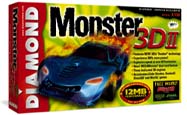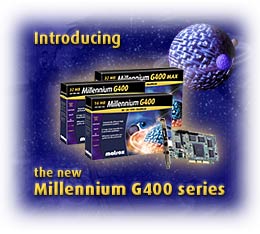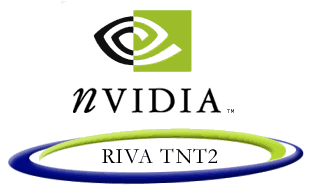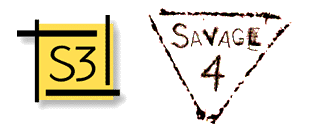| 3rd Generation 3D
Accelerators (By Rice-Dawg) VIDEO CARD ROUND-UPS AND BUYER'S
GUIDE _____I know what you're thinking. You're thinking, "What a dead boring article this is going to be. Who cares about 3rd Generation 3D accelerators. Gimme one of those red-hot Voodoo 3's!". Now, I'm not exactly an award winning writer, but this time, to keep your interest in a boring tech article, I'm including a short buyer's guide for people looking to play KINGPIN or QUAKE III: ARENA with sweet 3D polygons and acceleration. That also includes people who have cash growing on trees in the backyard to people that are digging up pennies under their sofa to buy a burrito. If you want to skip the tech mumbo jumbo, and get to the buyer's guide, just click! - The Boring Stuff _____Every video card you see on the market has 3 main components of it. There's the chip, which acts like the processor of the card. Then there's the circuit board itself, which acts like the motherboard of the card. And finally, there's the memory, better known as RAM of the card. All in all, it's not unlike a mini computer in itself. Video cards are very advanced gadgets, and also very fun to play with.
_____3D accelerators only became popular about 3 or 4 years ago, when the hit 3D game QUAKE took gamers by storm. Back then, 3D accelerators were separate video cards, acting as an addon for the existing 2D card in the computer. The 2D card is usually some cheap crap such as Trident or S3 good-for-nothings, which can run Windows, but that's about it. I'm not saying 3D acceleration did not exist back then, but they were definitely not used for games. They were mainly used for CAD engineers, and they were VERY bloody expensive. _____However, getting back to when QUAKE got released, a little company known as 3Dfx began hammering out Voodoo chips that provided 3D acceleration for QUAKE specifically. Remember, the "chip" is like the processor of a computer. 3Dfx developed the chip, but they sold the chip to other manufacturers to place on their "circuit board" and "memory". Back then, only a few companies got involved in this, Diamond and Orchid. Diamond bought 3Dfx chips and stuck them onto their circuit boards along with 4 megabytes of memory. Then they released it to the market in the form of Diamond Monster 3D. Ditto for Orchid, which released the Righteous 3D. _____You see, that confused a lot of people. Their friends are raving about their 3Dfx card, and so they go out to look for the label 3Dfx, but usually don't find it because what's displayed is the brand of the developer, such as Diamond and Orchid. However, people soon caught on, and the Monster 3D's and the Righteous 3D's started to fly off the shelf. _____Because of that, 3Dfx made a crap-load of money. The next chip that they developed was called the Voodoo 2. The Voodoo 2 nearly doubled the performance of the original Voodoo, and once again, 3Dfx cashed in pretty hard-core. Even today, the Diamond Monster 3D II are still very popular, and they come in 8 megs of RAM and 12 megs of RAM varieties. More and more companies began to jump on the 3Dfx bandwagon, such as Hercules, Quantum, STB, Canopus, Creative (of soundblaster fame), and much much more! It began to get very hard to distinguish one card from another because they were all so similar to each other. Customers began to get confused on which video card to buy, and most turned to the net to find out which was the best bang-for-buck. This began the video card reviewing trend that will continue on for a long time to come.
_____Up until then, 3D accelerators were ADDON cards, meaning you also had to have a 2D card in your system to run it. 3Dfx then released the Voodoo Banshee, which combined excellent 2D performance and in-between Voodoo 1 and Voodoo 2 3D performance. To those historian nitpickers, 3Dfx did release a chip known as the Voodoo Rush, which attempted to combine 2D and 3D, but failed horribly, so it sank into oblivion. I am one of the unfortunate souls which still lives with a Voodoo Rush, but hush... that'll be our little secret. =) _____Anyways, before I went off on a tangent, the Voodoo Banshee was the first successful 2D/3D combo card. Users that bought a card based on the Voodoo Banshee chip, such as the popular Diamond Monster Fusion or Creative Banshee Blaster no longer had to keep their cheap good-for-nothing 2D card. The success of the Banshee set the pace for today's top 3D accelerators, which are BOTH 2D and 3D. _____Today, 3Dfx has merged with the company STB and are now producing both chip AND board. Meaning there will be no Diamond Monster 3D III, because 3Dfx are no longer selling their chips out to manufactures. Why do that, when they have their own in-house board developer? An example would be ATi and Matrox, which develops both chip and board. _____3Dfx has recently developed the new Voodoo 3 chip, which comes in 3 variants: 2000, 3000, and the not-yet released 3500. The 3000 and the 2000 versions are the top 2 sellers of the month of June respectively, and for a very good reason. They're good and fast. However, this article will show you many more different paths to take, instead of the ignorant public view of only-3Dfx. You know, 3Dfx stock has been dropping steadily lately. Seems like more and more people are referring to the net to find out the truth behind all the advertising. =) _____Before, 3Dfx (now renamed 3dfx after their merger) was the king of the hill, simply because there was no competition. Now, competition is stiff, because other companies have dived into the gold mine that 3dfx first discovered. Most notably, NVidia. Instead of recounting the history of every company, I will focus on their latest and greatest chip, the TNT2 chip. They are still only chip producers, so they sell their chip out to manufacturers who puts the chips on circuit boards. Other competitors include the Matrox G400 chip & board, and the S3 Savage4 chip. There are so much more out there now, but for the sake of keeping this article short, I will focus on these major players. _____After their failure to re-capture the video card market with the G200, Matrox developed the all-new G400, which sports two very impressive features. One, the only card capable of handling hardware environmental bumpmapping, and two, the all new Dual-Head feature that allows simultaneous hook-up of two monitors doing separate tasks with the same video card! Combine those two features with the incredible fill-rate performance of the G400 and you get what many online magazines dub as their Editor's Choice.
_____NVidia's first competitive chip was the Riva128, and failed miserably against the almighty Voodoo. When the TNT chip was developed against the Voodoo 2, it held its ground thanks to its ability to render graphics at 32-bit (16.7 million colors + 8-bit stencil buffer) and that all TNT boards are 2D and 3D compared to the 3D-only Voodoo 2 card. Their new flagship, the TNT2, is everything that the TNT was with more horsepower and better 32-bit rendering pipeline.
_____S3 just very recently announced their plan to merge with Diamond multimedia, just as 3dfx has merged with STB. Just like 3dfx, they will also make both chip and board, and Diamond will no longer produce boards for other chip manufacturers such as NVidia. Speaking of S3, their latest flagship is known as the Savage4. Their previous chip, Savage 3D, pioneered the idea of S3TC, which stands for S3 Texture Compression. It's a standard technology present in Microsoft's DirectX, but only S3 has taken advantage of it. What the technology does is it can take a massive amount of texture, compress it, and then render it, making complex scenes in games such as Quake II or Unreal run much smoother. The drawback is that the software companies that develop the games must actively program codes that take advantage of S3TC. Unfortunately for S3, their Savage 3D chip suffered from massive incompatibilities and bugs, so it never took off as a competitor to 3dfx's Voodoo 2 or NVidia's TNT. Their new Savage4 also supports S3TC, and is also much more stable. However, the speeds of the chip are still no match for the TNT2 or the Voodoo 3.
_____So what happened to 3dfx? The king of 3D gaming acceleration developed their new motto that anything under 60 frames per second (FPS) was unacceptable. They even produced a demo to show that there IS a difference between 30 FPS and 60 FPS. That argument is an article in itself. Anyways, the Voodoo 3 definitely lives up to their motto of >60 FPS, because the Voodoo 3 is a total speed demon. However, the drawback lies in 3 very ugly non-features. No support for 32-bit color rendering, only 16 MB of onboard memory, and does NOT take advantage of Accelerated Graphics Port (AGP). _____3dfx's Voodoo 3 only has support for 16-bit color rendering (67,000 colors, compared to 32-bit's 16.7 million colors PLUS 8-bit stencil buffer), because they firmly believe that the jump to 32-bit colors will kill framerate so that it will be under 60 FPS. Remember their motto? In addition, all 3 models of the Voodoo 3 board (2000, 3000, and 3500) have only 16 MB of onboard memory. They insist that because they do not utilize 32-bit color rendering, 32 MB or RAM would be too expensive for the consumers. Finally, the AGP port is a new standard on 440BX motherboards. Don't understand what I'm talking about? Rip open your computer case and look at your motherboard. You should see 2 to 4 long, black slots, with some taken up by your modem or soundcard, 4 or 5 shorter white slots, with some taken up by your network card or your video card, and one brown slot. That brown slot is the AGP slot, and is made specifically for video cards, so don't try to cram a soundcard in that slot. If you can't find one, it either means you already have an AGP video card, OR your motherboard is too old and it's time to upgrade! =)
_____"But Rice! Doesn't the Voodoo 3 come in AGP form??" Well, yes, but they don't take advantage of what the AGP slot provides. The AGP slot provides dedicated bandwith to shove graphics and 3D polygons through your computer so overall graphics acceleration is faster. What 3dfx does is that they have their own standard, but they develop the card for AGP anyway. That creates an illusion that AGP Voodoo 3's are faster than PCI Voodoo 3's, but don't believe it. |

 _________
_________



